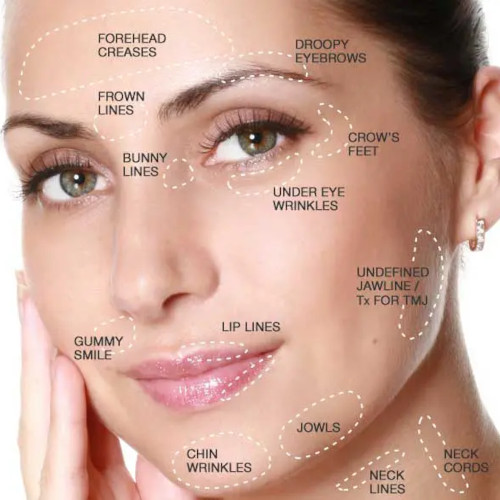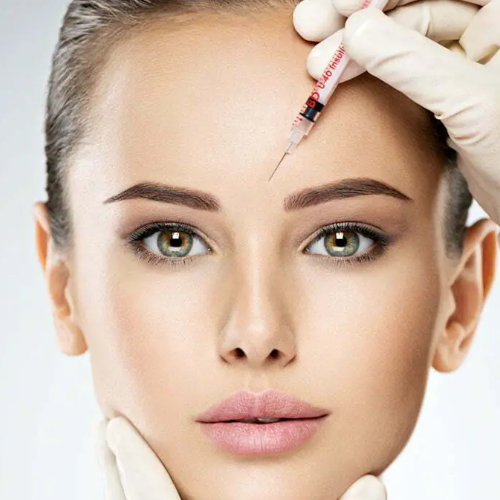
What are dermal fillers?
Our guide to cosmetic filler injections
Dermal fillers are gel-like substances that are injected under the skin to create a fuller or smoother appearance.
They are used to:
Dermal fillers are a minimally invasive procedure that is often performed in a doctor's office. The procedure usually takes less than an hour and recovery time is minimal. Results are visible immediately and can last for 6-12 months, depending on the type of filler and the location.
As you age, your body starts to lose collagen. Collagen is an important substance that exists all over your body, including in your skin, muscles, bones and connective tissues. Decreased amounts of collagen in your skin causes skin laxity (loose) and loss of volume. Skin becomes thinner, loses its elasticity and starts to sag.
As time goes on, our bodies produce lower amounts of the proteins which give us a youthful look – namely elastin and collagen. Dermal fillers work to smooth the deep lines in the face which appear as wrinkles. This injectable treatment is able to add volume which has been lost in these areas since elastin and collagen production has dropped. In this way, dermal fillers are able to enhance the appearance of the face, adding ‘lift’.
Patients will typically attend an initial consultation with a dermatologist at the Skin Science Clinic, at which their suitability for the treatment can be confirmed. The dermal fillers procedure can involve a series of injections, depending on the requirements of the individual. In preparation for the injection, the targeted part of the face is numbed with a topical anaesthetic cream. The injection into the skin is administered to a mid or deep level.
Following a dermal fillers injection, patients can resume their everyday activities, including the application of makeup. It is recommended that patients refrain from rubbing or massaging the affected area of the face for a few days after the treatment.
There is a level of debate on the age at which collagen and elastin production begins to decrease, but it is accepted that this is around 25.
From then on, we can expect a steady decline of elastin and collagen.
The production of these proteins stops altogether by the time we reach our late twenties.
For this reason, dermal fillers may be considered as a cosmetic treatment by anyone in their late twenties or older.
Other possible good candidates for dermal fillers include non-smokers, those who are in good physical condition, and individuals who habitually take good care of their skin.
So exactly which are the benefits of dermal fillers that make them such a compelling cosmetic treatment? In this section, we take a look:
NATURAL LOOKING RESULTS
One thing which most cosmetic treatment patients have in common is that they want natural looking results. Nobody wishes to be left with the tell-tale signs that they have had cosmetic work done. Dermal filler injections are able to offer this desirable, natural look, which retains the normal movements and expressions of the face. This is in contrast to procedures which can result in lasting changes to the recipient’s facial expression. That’s thanks in part to the more gradual process of dermal fillers, which plump out targeted areas of the face over time.
MINIMALLY INVASIVE
Unlike plastic surgery, dermal facial fillers are a minimally invasive treatment. Not only does this mean that the procedure itself is less drastic than many surgical options carried out by plastic surgeons, but it also makes the treatment shorter than many more intensive options. Depending on the type, a dermal filler procedure will generally take under an hour, meaning that they need not disrupt the everyday activities of the patient. The recovery time is negligible, and that is compared to the rest time of between four to six weeks which is required by surgery.
FASTER THAN CREAMS
Anti-ageing creams are favoured by some seeking to combat the natural effects of ageing, such as the decrease in elastin and collagen production. While results are possible from these type of cosmetic products, they can take months to appear. These type of creams can be seen as a long-term skincare option, whereas dermal fillers offer results which are almost instant in some cases. All that is required is to inject filler into the right areas.
NON PERMANENT
Because dermal fillers are a minimally invasive treatment which typically use hyaluronic acid that the body produces naturally, the effects gradually wear away over time as the acid is reabsorbed. For many, this is seen as an advantage, as it does not require a commitment to permanent surgery. Dermal fillers can be topped up periodically, allowing us to retain a youthful appearance in the long run, without surgery. And it should be noted that the effects usually last up to 18 months, meaning that dermal fillers are not typically required at regular intervals.
REVERSIBLE
If for any reason a patient is not happy with the result of their dermal fillers treatment, there is a simple solution, and that is to reverse the effects immediately. In these cases, an enzyme known as Vitrase is used. It can be injected soon after the procedure and is capable of reversing the effects in a very short time.
If you are unacquainted with the range of cosmetic facial treatment options, you might be unsure of the difference between dermal fillers and Botox. The truth is that these two treatments, while similar in some respects, are virtually a world apart in others.
Botox and dermal fillers are both minimally invasive skin treatments with the same general objective of addressing wrinkles, but among the key differences is that Botox can only be effective on facial lines which are the cause of muscle movement, rather than a loss of plumpness. That means that Botox can be effective in treating ‘crow’s feet’ around the eyes, as well as horizontal lines which are found on the forehead. That’s because these lines are caused by squinting or frowning. It will not be effective in addressing ‘static wrinkles’ which are facial contours that are the result of sagging lower down in the face including ‘smile lines’ (nasolabial folds).
It should also be noted that Botox works in an entirely different way to dermal fillers. Botox uses botulinum toxin and serves to block out nerve signals in the muscles when injected into target areas. This has the effect of ‘freezing’ the muscle, and consequently, the lack of movement in the targeted area may soften wrinkles, or reduce them significantly..
Carried out by a skilled dermatologist at the Skin Science Clinic, the injections required for dermal fillers should not hurt the patient.
The injection itself contains a local anaesthetic, which numbs the injection site and can negate pain during and after the procedure.
Dermal fillers are recognised as a minimally invasive, safe procedure.
Because the hyaluronic acid which is used in the treatment is naturally occurring in the body, there is no recognised risk of an allergic reaction.
The type of filler which is used by us is Premium Juvederm and is of the highest quality, and used by the world’s most respected skin clinics.
The treatment is quite quick and can be carried out in about 60 minutes.
Most people experience mild swelling or bruising for a few days following treatment. Full recovery is typically within two weeks. You can resume normal activities immediately.
After the treatment, you can expect to see results immediately. Over a two to a four-week period following the procedure, results will gradually become even more apparent.



